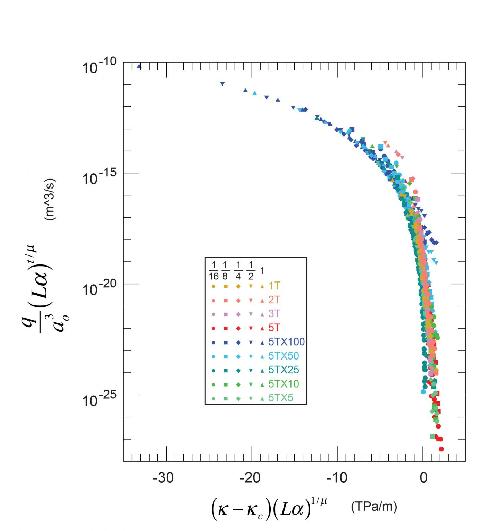WEST LAFAYETTE, Ind. -- A team of researchers has created a way to quickly and remotely evaluate fluid flow in subsurface fractures that could impact aquifers, oil and gas extraction, sequestration of greenhouse gases or nuclear waste and remediation of leaked contaminants.
Laura Pyrak-Nolte and David Nolte, both professors of physics at Purdue University, found a nearly universal scaling relationship between fracture stiffness and fluid flow that applies to low porosity rock, or roughly more than 50 percent of all rock on Earth.
Through this mathematical relationship the pair created a tool that, through a fracture's stiffness and depth, can reveal its potential fluid flow rate, which can be used to predict flow path and evaluate the hydraulic integrity of a site.
 A graph of the scaling relationship between fluid flow and fracture stiffness is shown. The shape of the symbol indicates the fracture length scale from 0.0625 meter (circles) to 1 meter (triangle) and the colors correspond to different apertures. Credit: (Image courtesy of Pyrak-Nolte)
A graph of the scaling relationship between fluid flow and fracture stiffness is shown. The shape of the symbol indicates the fracture length scale from 0.0625 meter (circles) to 1 meter (triangle) and the colors correspond to different apertures. Credit: (Image courtesy of Pyrak-Nolte)
It has been difficult to create a universal way to evaluate fractures because of the wide range of sizes, from microns to kilometers. In addition, fractures in the Earth are dynamic and subject to frequent changes in stress, chemistry and fluid pressures, said Pyrak-Nolte, who led the work.
"When you look at all of these very different fractures, it seems like each would be different and the rates at which fluid could flow through them would be different," she said. "Now we have found the single underlying physical principle that explains them all."
The team also showed that high frequency wave measurement, in which seismic waves are used like radar to provide the basic dimensions of a fracture, can be used to obtain the stiffness of a fracture. When this technology is paired with the new scaling law, it allows for a remote scan of a fracture to reveal the potential fluid flow at a particular site and also to monitor potential changes in fluid flow at a site over time, Pyrak-Nolte said.
The findings are detailed in a paper in the journal Nature Communications that is currently available online.
Throughout her career Pyrak-Nolte has studied fractures in the Earth's subsurface and has developed tools and gathered information that led to this finding.
"Through decades of study of fractures and related science, we were able to pull together all of the threads and see the pattern in the tapestry," said Pyrak-Nolte who also has courtesy appointments in the Lyles School of Civil Engineering and the Department of Earth, Atmospheric and Planetary Sciences. "I think this is a good example of the importance of long-term funding. Without the long-term support of the Department of Energy, I wouldn't have had the steady exposure in this area necessary to arrive at the creation of a very useful and practical tool."
Fractures have been considered one of the most difficult things to deal with in subsurface activities and their study has been a major area of focus for the DOE, said Nolte, who is Purdue's Edward M. Purcell Distinguished Professor of Physics.
"The units of measurement that describe the different fracture properties span 10 orders of magnitude, which means fluid flow varies by 10 orders of magnitude or more - fractures are mathematically all over the place," he said. "If you had asked me just one year ago, I would have said there may not be a single relationship to bring it all together. We thought it might be different for each class of fracture. However, once we figured out the parameters and keys to linking them together, the data collapsed into one beautiful curve. It is amazing how radically different topologies can be and yet still be described by the same physical principle."
The researchers created mathematical functions that tie together mechanical and hydraulic properties of the fractures. From these mathematical functions they were able to create a graph in which one can use a fracture's stiffness to pinpoint where it falls in a curve describing fluid flow. The information and graph is freely available.
The team also looked at what would happen if a fracture eroded, as could occur during carbon sequestration, and found that the scaling law still held, Pyrak-Nolte said.
The stiffness of a fracture depends on the points of contact of the two surfaces involved. The more points of contact, the more stable or stiff the fracture. The key to linking this stiffness with fluid flow rate was the geometry, because both characteristics depended on a shared geometry, Nolte said.
The duo ran more than 3,600 simulations for each fracture type using Purdue's Rosen Center for Advanced Computing.
"For years this was our hypothesis and now it has finally been demonstrated," he said. "In the past people used averages from among the many different classes of fractures to inform their decisions, but these averages missed key points. Now we have a functional framework of how to treat fractures of different depths that captures important nuances."
In the future, the team hopes to further validate the methods at a field site with known fractures and to pursue the creation of a similar framework for the behavior of networks of fractures.
source: Purdue University